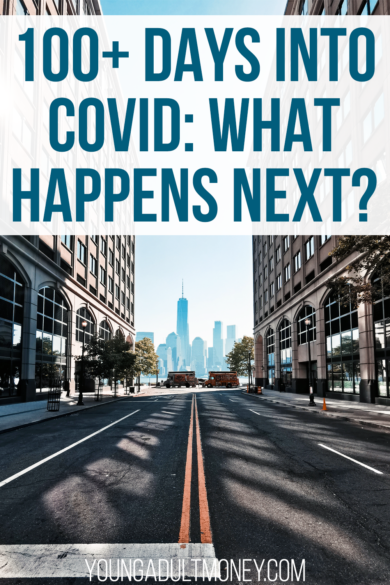 It’s now been more than 100 days since COVID took a hold on the United States.
It’s now been more than 100 days since COVID took a hold on the United States.
COVID has resulted in mass-shutdowns of businesses, schools, and workplaces, led to stay-at-home orders, social distancing and mask-wearing, and ultimately took the US economy from a sprint to a crawl.
We’ve seen tens of millions of Americans file for unemployment.
The Federal Government has taken large-scale actions to prop up the economy including hundreds of billions of dollars in business aid, stimulus checks sent directly to citizens, and unemployment assistance at such a high level that many who receive it are making more than they were when they were fully employed.
The Federal Reserve has also taken action with near-zero interest rates and other actions that equate to trillions in aid.
Some states have begun re-opening their economy, but in some states that have been more aggressive in re-opening such as Florida, Arizona, and Nevada the number of cases have increased. Many people are experiencing fatigue from the past three months of isolation – and subsequently becoming lax or outright ignoring social distancing and mask-wearing – as a result.
With the economy largely propped up by massive government intervention and COVID seemingly here to stay through at least the remainder of 2020, many are wondering: what happens next?
The extra $600 a week in federal unemployment benefits expires July 31st.
But there are many who either won’t be able to go back to work or won’t be able to find a job if they want one, until a vaccine is widely available or herd immunity is achieved.
Without another round of business assistance from the Federal Government there is a good chance many businesses will have to either lay off additional employees, or if they have been able to retain their entire workforce up to this point, make an initial round of layoffs. This is especially true of companies that were hard hit by COVID, such as airlines and hotels, which may not see their previous level of business return for a number of years.
Testing has improved, which is helpful to allow certain aspects of life to return to “normal.” The English Premier League, for example, resumed play last week (albeit to empty stadiums).
But until we have a vaccine, we won’t see the economy return to what it used to be.
Unfortunately it’s impossible to predict when a vaccine will be available.
Which brings us back to government aid.
What do we know about another round of COVID stimulus from the Federal Government?
Needless to say, there has been a lot going on in the world.
For the past month a global pandemic became secondary in the news cycle to worldwide protests around the killing of George Floyd and larger systemic racism that exists today.
That doesn’t mean elected officials haven’t given thought to another round of stimulus.
In fact if you remember back to mid-May, the House of Representatives passed the HEROES Act, which included $3 trillion in additional COVID relief. (Kelly Phillips Erb at Forbes gave a great round-up of what is included in the bill).
This bill was a Democratic effort, though, and did not involve negotiations with Senate Republicans or the White House. Democrats framed it as their way of laying out what they think the next round of stimulus should look like, leaving the ball in the Republicans court to put together a counter-proposal.
While there are many things included in the HEROES Act, the two things people likely are most interested in were:
- Another round of stimulus checks of $1,200 per eligible adult and $1,200 per dependent (instead of the $500 per dependent in the CARES Act)
- An extension of the $600/week surplus federal unemployment benefits through January 31, 2021
Despite many Republicans admitting that another round of stimulus is needed, Republicans have attacked various aspects of the HEROES Act and certainly will not bring it to vote, let alone pass it, as is.
With that in mind, what are they open to?
One thing that many have hinted as an option, including Senate Majority Leader Mitch McConnell, is a second round of stimulus checks.
What they are seemingly not supportive of is extending the supplemental $600 a week federal unemployment benefit.
If unemployment numbers come in better than expected the next few weeks we can expect Republicans to become even less fond of the idea of extending federal unemployment benefits. Conversely, if they come in worse, they may be more open to some sort of compromise.
Republicans have also floated the idea of giving some sort of bonus to people who return to work. The rational being it gives an incentive for going back to work, while generous unemployment benefits act as a disincentive.
Assuming a compromise can be reached, we should see a another round of stimulus pass the House, Senate, and White House after the 4th of July Holiday and before the end of July.
In fact, in mid/late June President Trump said that another round of stimulus will happen and that details will be revealed in the coming weeks.

My predictions:
- A second round of stimulus checks – Likely at the $1,200 per adult and $500 per dependent level that we saw in the CARES Act
- Some compromise on unemployment benefits – Perhaps $200/week supplemental instead of $600
- A “return to work” bonus
- Student loan relief extended through the end of the year (more on that next)
- Another round of business relief, most likely forgivable business loans and direct relief to hospitals and the health care system
This is all speculation at this point, of course, and I’ll be keeping tabs on how things develop the next few weeks.
What about Student Loans?
Federal Direct student loans have been paused through the end of September, 2020. No interest will accrue, nor will any payments be required from borrowers. These months where payment is not required will count towards student loan forgiveness programs
Read my full overview of what is happening to your student loans during COVID for more information.
I also give some tips on what to do while your student loans are paused during COVID. Spoiler alert: do not make voluntary payments.
As far as what happens next with student loans, I think there is a good chance that the pause on Federal Direct student loan payments will be extended from the end of September to the end of December.
In the Democrats HEROES Act I mentioned earlier, there was originally some provisions for the government to provide relief for private student loan lenders, who have so far been left completely out in the cold. Those provisions did not make it in the final bill.
If you do have private student loan debt I share a couple of strategies of what to do during COVID.
If Democrats concede that it is unlikely the Republican Senate will allow private student loan relief in the next bill, they may push harder for relief of federal student loans. Good news for federal student loan borrowers, but unfortunate news for private student loan borrowers.
What Happens Next?
What happens next is another round of economic stimulus is passed by the Federal Government. We don’t know what it will look like, but the odds are very high some agreement will be made between the Democrats and Republicans.
Things won’t truly get back to normal until we have a vaccine, and the assumption is that we will have a vaccine before herd immunity would theoretically be achieved. That could be the end of 2020, or 2021.
I personally think gaining an understanding of how government policy impacts your money is underrated. That’s why I’ve focused so much on policy in this post.
But at some point you have to look at what you can do proactively, including actually taking advantage of that policy. For example, the government can put student loan forgiveness into law (PSLF and income-driven loan forgiveness), but it is up to each person to actually learn about it and take advantage of it.
Let’s start by talking about being unemployed during COVID. We have an entire post on COVID unemployment benefits. We also have a post that focuses on increasing cash flow when you are unemployed due to COVID.
There is nothing wrong with being unemployed during a pandemic. With that being said, your unemployment may last quite some time, depending on what your job is and how hard hit your industry was.
Refreshing your resume, tapping into your network, and looking at job postings regularly are all proactive things you can do to put yourself in the best position of landing a job. Beyond that, though, you shouldn’t put a lot of pressure on yourself to be productive. Sure, it’s great if you take up running and read a book a day. Many are struggling with the mental and emotional tole of COVID, though, and are struggling even if they have a job. Be easy on yourself.
Still employed during COVID? I outline a number of things you should do, including making sure you have a healthy emergency fund before even thinking about tackling debt.
Here are a few other posts you may be interested in:
Ways to Feel in Control During Uncertain Times
15 Ways You Can Make Money From Your Computer Right Now
List of Companies that Will Pay You to Deliver
The Jumbo Emergency Fund: The Rise of the 12-Month Emergency Fund

